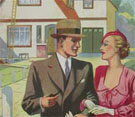Exhibition: Middle-class interiors
An enterprising new exhibition covering 150 years of English middle-class interiors examines the demarcation of male-female influence in the home, reports Amicia Moubray


The past 25 years have seen an explosion of interest in decorating, both contemporary and historic, yet little attention has been devoted to the evolution of the middle-class interior. This is partly due to the paucity of pictures, documents and surviving examples, added to the fact that before the expansion of the moneyed middle classes in the mid 19th century, the ‘middling sort’, as they were known, were a relatively small part of society and did not have the wherewithal to contribute significantly to furnishing trends.
Recently, the delightful Geffrye Museum in the East End has made enormous strides to address this neglected area of scholarship. ‘Choosing the Chintz: Men, women and furnishing the home, 1850 to the present’ is its latest show on this theme and examines the sharply defined demarcation of the masculine and feminine in middle-class interiors.
In the 19th century, studies, dens, smoking, billiards and dining rooms were traditionally male domains; the drawing room was the preserve of the ladies. ‘It was often a question of space for the middle classes, with studies doubling as smoking rooms,’ says Christine Lalumia, the Geffrye Museum’s deputy director. The successful Victorian man was keen to celebrate his status and his patriarchal role, and his home was the obvious vehicle. Sir William Orpen’s painting of the Nicholson family demonstrates this: William Nicholson dominates, presiding over his family in their Bloomsbury dining room.
To this day, dining rooms are perceived as masculine rooms, ‘the arrangement of which must depend entirely on the individual tastes and pursuits of the master of the house, whose room this is more especially,’ wrote Jane Ellen Pantin (1848-1923), author of decorating advice manuals and the daughter of the celebrated painter William Powell Frith. In The Forsyte Saga, Soames retires one evening to his dining room, which then doubles up as a smoking room: ‘the fire was bright, his chair drawn up to it, slippers ready, spirit case and craven cigarette box on the table’.
Smoking rooms were also male sanctums. Sir Thomas Beecham recalls in a letter his father retiring to his ‘holy of holies’ wearing a cap of Turkish design and a richly coloured jacket—‘I would gaze upon this gorgeous spectacle with rapture’. In an 1858 painting, Henry Lambert, a master sailmaker and chandler, is shown in the parlour of his prosperous Wapping home, presumably above the business premises, the middle-class equivalent of an aristocrat in front of his country seat. Such a detailed depiction of a 19th-century interior of this status is rare, and it provides a fascinating record of middle-class taste, from the wax fruit in a glass dome to the floral fitted carpet and trellis wallpaper.
The right to vote, coupled with The Married Women’s Property Act of 1882, gradually empowered women, and a growing number of home magazines capitalised on this. Columns were devoted to questions about furnishing and decoration, answered by female writers known as ‘decorators on paper’. By the 1920s, Furnishings, the leading trade journal of the time, stated ‘…woman is the purchaser of at least 90% of the furnishings for the home’. This is encapsulated in The Bride’s Book of 1938: ‘Being a bride is a serious as well as a romantic matter. She is the selector and buyer of nearly everything that will be required to establish her home and to maintain it.’
Today, dual incomes and the proliferation of decorating ideas has led to couples making joint decisions. But stereotypes still persist: ‘He can pick the electronic stuff, as long as I know how to turn it on’ is the attitude of many 21st-century women.
Exquisite houses, the beauty of Nature, and how to get the most from your life, straight to your inbox.
‘Choosing the Chintz: Men, women and furnishing the home, 1850 to the present’ is at The Geffrye Museum, Kingsland Road, London E2 from October 14 to February 22 (020–7739 9893; www.geffrye-museum.org.uk)
Country Life is unlike any other magazine: the only glossy weekly on the newsstand and the only magazine that has been guest-edited by His Majesty The King not once, but twice. It is a celebration of modern rural life and all its diverse joys and pleasures — that was first published in Queen Victoria's Diamond Jubilee year. Our eclectic mixture of witty and informative content — from the most up-to-date property news and commentary and a coveted glimpse inside some of the UK's best houses and gardens, to gardening, the arts and interior design, written by experts in their field — still cannot be found in print or online, anywhere else.
